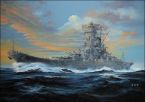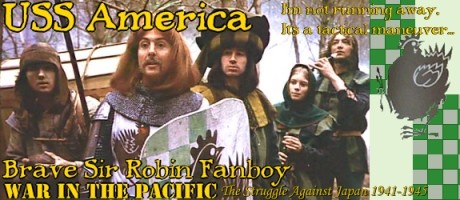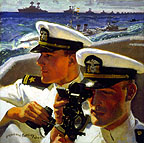AW1Steve
Posts: 14507
Joined: 3/10/2007
From: Mordor Illlinois
Status: offline

|
quote:
ORIGINAL: Chickenboy
quote:
ORIGINAL: Bullwinkle58
quote:
ORIGINAL: Chickenboy
For all the hotshot submarine stud Captains that get their photos of a CVN's screws, I wonder if they're detected coming in. For these wargames, I wonder if the ROE allow the submarines to be hit by active sonar from dipping helicopters or blasted by concerted ASW attacks. In the case of that Collins' class submarine pictured above, that's a dead sub by my reckoning. I wonder if the submariners realize that they just got greased in their quest for fame. In real life, any submarines detected in the CVNBG region would be treated with the utmost hostility. In peacetime, the risk:reward just isn't there for these guys, so they can shoot the moon.
Also, there's a benefit for CVNBGs to lament how open they are to attack by submarine. "Oh, look how easily our screen can be penetrated! Please, oh please Mr. enemy man, please don't try to track us with your submarines! Look how closely you can get! We're defenseless!" I wonder whether these same vulnerabilities would be echoed in wartime or whether the ASW is-perhaps-more formidable than letting on.
OK, this thread forced me to resurface for a day. Waaaaaay too many zoomies and not one self-IDed bubblehead. 
I served in a boomer and not a fast boat, but I've done ASW wargames, and I've been an OOD being hunted by a P-3. That was NOT a wargame, but a realio trulio situation one dark night near Grenada where the ROEs were not well understood and certain command silos didn't talk to other command silos about who was or wasn't a Soviet SSN real near a certain location where Cuban troops were getting beat upon. I have respect for the P-3. I know what one sounds like going over the control room about 50 feet off the deck. And yeah, MAD works real good. Also periscope-finding radar. If I were being hunted by the USN's ASW troops I'd have my Page 2 filled out. OTOH, in a hot war we would not have been at PD doing the evolutions we were doing when that P-3 got us.
As far as the USN gutting ASW capability in the 1990s, well, yeah. The guys with subs we were worried about left them rusting at the pier where the sats could see them, and we had other priorities like no-fly zones to use up the O&M appropriations. Coordinated ASW is by far the hardest, most complex naval evolution there is. Harder than an amphibious landing I'd argue. If you don't train for it all the time you get bad at it pretty fast. But after the USSR fell apart the only submarine threat on the horizon was littoral D/Es and AIPs, and most of those were owned by friends. This has changed somewhat, but the littoral part hasn't much. D/Es are cheap, and they have limited capabilities to match. As others who served longer than me in different roles have said here the famous "hole in the water" is somewhat true (a lot less than laymen who don't understand narrowband processing think), but that carries with it the downside of slow or no mobility.
Also not mentioned to date is that the very best ASW is not at sea. At sea is the absolute hardest place to sink a submarine. At the pier loading groceries is the easiest. The USSR had air defenses and geography such that their submarine support facilities were pretty much untouchable. Certain other D/E-owning adversaries not so much. Cruise missiles, B-2 attacks, carrier air wings, or SEAL penetrations and the spare parts, repair technicians, and torpedo inventories go away. Then the threat is only those boats at sea, and they are a perishable commodity.
As far as wargames go, yeah, there are a lot of pictures on both sides of the coin. Unspoken of here are times when the sub-launched flares signalling a simulated warshot landed on the flight deck of the unsuspecting carrier. Or that it was normal in the old days for SSNs playing OPFOR to have diver-installed sound enhancers (called "clappers" for some reason in the boats, but also other names) at the stern to make it a more fair fight for the poor sonarmen in the skimmers. But in my limited experience those wargames were done to help pre-deployment workups of CVBGs, not necessarily to help the sub drivers. A launch range where the flares are visible from the carrier is stupid.
You speak of "screens", and those still exist, but I'm afraid you're picturing a WWII screen where the escorts are in blinking-light distance of the carrrier. Consider that the USN Web site lists the MK48 ADCAP torpedo's range as "in excess of five miles." It's trivial to find other on-line sources with other ranges, 27 miles being not uncommon. I'm not saying, but let's use the latter figure for discussion. Consider a moving circle 54 miles in diameter around the carrier. Also consider that the Mk48 is wire-guided as well as programmable in three-dimensions. Any number of inbound multiple-leg courses can be programmed in to disguise the launch vector. Some can be launched to run shallow, some deep, taking advantage of known sound channels. Early launches can run in active to feed data back to the sub for wire-guided course corrections on later fish. Some can run in passive, with different search patterns inserted. And, while an SSN can only actively control a set number of wire-guided weapons, it can RAPIDLY launch many, many non-guided MK48s. The magazine capacity of the Seawolf class, for example, is 50, and the reload cycle is the work of minutes these days, not the hour or more of WWII with sweating men and chainfalls.
Combine the above with the fact that much airborne and surface ASW focuses on localization and attack on subs known to be in that 54-mile circle. But subs don't act like knights charging in on a TF with lowered lance. They don't fight fair. They're assassins. In most cases a task force's first hint that a sub is near is going to be reports of an incoming torpedo. As someone above said, the best defense a CVN has is that reactor and hoping to run away really fast. But again, good attack planning is going to place other weapons in the path of that run away. And any TF important enough to have integrated ASW is going to rate more than one SSN. We learned something from the Germans.
The world has never seen an SSN-driven anti-shipping campaign, and I hope it never happens. It would be short and brutal. Today, again, the best ASW weapon is another sub, and an SSN, for all its disadvantages, is the best sub for the job. Not very many nations have them, or if they do they don't have the IT capability to make their sonars work as well as ours. Whoever gets the first shot off usually wins. China may be a problem someday, but isn't now. Kilo and other exported D/E models in the hands of nations with little experience using them are to be respected, but aren't the wonder weapons some think. Yes, they are sometimes trotted out at funding time, but in the scheme of total defense budgetary demands they aren't a Top-5 worry. As I said up above, the USN's ASW capability even in these days of restained effort is by far the best in the world, and were I in a sub opposing it I would be very worried. The other direction? Not a lot there.
Damn interesting post, Bull. You should "surface" more often, you bubblehead you. 
As an aside, what's a page 2?
Glad to finally have the "bubblehead" perpective!  A page 2 is the "I volunteer" part of the service record. You Volunteer for the USN, then volunteer again for subs or flying. You "unvolunteer" by "signing your page". The USN then strips you of your Wings/Dolphins and is VERY displease with you. A page 2 is the "I volunteer" part of the service record. You Volunteer for the USN, then volunteer again for subs or flying. You "unvolunteer" by "signing your page". The USN then strips you of your Wings/Dolphins and is VERY displease with you.
_____________________________
|
 Printable Version
Printable Version































 New Messages
New Messages No New Messages
No New Messages Hot Topic w/ New Messages
Hot Topic w/ New Messages Hot Topic w/o New Messages
Hot Topic w/o New Messages Locked w/ New Messages
Locked w/ New Messages Locked w/o New Messages
Locked w/o New Messages Post New Thread
Post New Thread